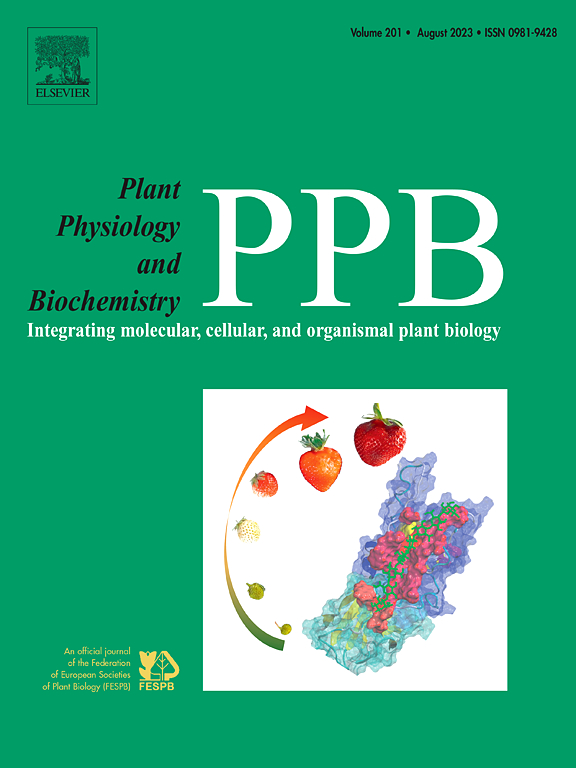在根际有一种类似多磷酸酶的酶催化长链多磷酸水解的证据
IF 5.7
2区 生物学
Q1 PLANT SCIENCES
引用次数: 0
摘要
由两个或多个磷酸单元组成的聚磷酸盐(poly-Ps)只有在水解成正磷酸盐(orthop)后才能成为植物可利用的物质。虽然微生物的多磷酸酶有很好的文献记载,但没有证据表明植物分泌到根际的胞外多磷酸水解酶。本研究旨在评估植物水解长链和环状聚磷形式的能力,并确定细胞外水解活性。6种植物分别在添加环聚磷和正磷的无菌培养基中生长,以评估其水解和利用不同磷源的能力。不同物种利用聚磷的能力有显著差异。生菜表现出较差的生长,而辣椒的生物量水平与正磷相当,这为根际水解活性提供了直接证据。用完整组织进行的水解试验证实,辣椒根部的活性明显高于生菜,而叶片的活性在两种植物中均最低。研究了辣椒根蛋白提取物的酶活性。热处理消除了水解,证实了酶的中介作用。液相色谱法能够分离出具有高聚磷水解活性的~ 20 kDa蛋白,超过已知的植物磷酸酶。活性组分质谱分析鉴定出一种无细菌同源物的辣椒蛋白(STH-21),支持其植物来源。活性组分表现出较强的聚磷水解,水解效率随链长增加而降低。本研究首次提供了维管植物中存在多磷酸酶样酶的证据。一种能够水解长链多聚磷的细胞外、根源酶的发现挑战了植物完全依赖土壤微生物水解复杂多聚磷的普遍观点。本文章由计算机程序翻译,如有差异,请以英文原文为准。
Evidence for a polyphosphatase-like enzyme catalyzing the hydrolysis of long-chain polyphosphates in the rhizosphere
Polyphosphates (poly-Ps), composed of two or more phosphate units, become plant-available only after hydrolysis to orthophosphate (ortho-P). While microbial polyphosphatase enzymes are well documented, no evidence exists for extracellular poly-P-hydrolyzing enzymes secreted by plants into the rhizosphere. This study aimed to evaluate plant capacity to hydrolyze long-chain and cyclic poly-P forms and to identify extracellular hydrolytic activity.
Six plant species were grown in sterile media supplemented with either cyclic poly-P or ortho-P to assess their capacity to hydrolyze and utilize different P sources. Species varied markedly in their ability to use poly-P. Lettuce displayed poor growth, while pepper achieved biomass levels comparable to ortho-P, providing direct evidence of rhizospheric hydrolytic activity. Hydrolysis assays using intact tissues confirmed significantly higher activity in pepper roots compared to lettuce, with leaves showing the lowest activity in both species.
Protein extracts from pepper roots were assayed for enzymatic activity. Heat treatment eliminated hydrolysis, confirming enzymatic mediation. Liquid chromatography enabled the isolation of a ∼20 kDa protein exhibiting high poly-P hydrolytic activity, exceeding that of known plant phosphatases. Mass spectrometry of the active fraction identified a Capsicum annuum protein (STH-21) with no close bacterial homologs, supporting its plant origin. The active fraction showed strong poly-P hydrolysis, with efficiency declining as chain length increased.
This study provides the first evidence of a polyphosphatase-like enzyme in vascular plants. The discovery of an extracellular, root-derived enzyme capable of long-chain poly-P hydrolysis challenges the prevailing view that plants depend solely on soil microorganisms for hydrolyzation of complex poly-Ps.
求助全文
通过发布文献求助,成功后即可免费获取论文全文。
去求助
来源期刊
CiteScore
11.10
自引率
3.10%
发文量
410
审稿时长
33 days
期刊介绍:
Plant Physiology and Biochemistry publishes original theoretical, experimental and technical contributions in the various fields of plant physiology (biochemistry, physiology, structure, genetics, plant-microbe interactions, etc.) at diverse levels of integration (molecular, subcellular, cellular, organ, whole plant, environmental). Opinions expressed in the journal are the sole responsibility of the authors and publication does not imply the editors'' agreement.
Manuscripts describing molecular-genetic and/or gene expression data that are not integrated with biochemical analysis and/or actual measurements of plant physiological processes are not suitable for PPB. Also "Omics" studies (transcriptomics, proteomics, metabolomics, etc.) reporting descriptive analysis without an element of functional validation assays, will not be considered. Similarly, applied agronomic or phytochemical studies that generate no new, fundamental insights in plant physiological and/or biochemical processes are not suitable for publication in PPB.
Plant Physiology and Biochemistry publishes several types of articles: Reviews, Papers and Short Papers. Articles for Reviews are either invited by the editor or proposed by the authors for the editor''s prior agreement. Reviews should not exceed 40 typewritten pages and Short Papers no more than approximately 8 typewritten pages. The fundamental character of Plant Physiology and Biochemistry remains that of a journal for original results.

 求助内容:
求助内容: 应助结果提醒方式:
应助结果提醒方式:


